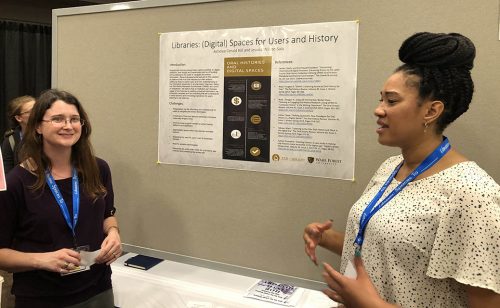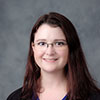This article is more than 5 years old.
Of the things I’ve always wanted to do, but never had the opportunity, attending a professional conference has always been high on my list. I figured I’d give NCLA a try since it was in Winston-Salem and I’d been encouraged to submit a poster with Ashelee from Special Collections and Archives. There weren’t so many people that I felt overwhelmed (though still very tired from all the people-ing in a day) and was able to make meaningful connections with the professionals I did interact with. There were a lot of very informative sessions, some that left a bit to be desired, and others that let me know I’m on the right track with some ideas I have. Here are some of my session highlights, followed by a review of the poster presentation. Stay tuned at the end for Hot Takes!
Libraries: Spaces for Everyone – Web Accessibility Basics and Beyond
I attended the pre-conference specifically for this session. As a web developer, and someone who has friends and family that suffer from web accessibility issues, this has been high on my priority list for understanding and improving within my own workflows. The presenters went over the Web Content Accessibility Guidelines 2.1 (WCAG 2.1) and how they look when applied to technology. As accessibility (both physical and digital) has been a touchstone for me throughout my professional life, these guidelines spelled out in a much more understandable way (vague would be an understatement for some of them) was truly powerful.
Linked Data Experiments in NC Libraries
Linked data is, in short, the “collection of interrelated datasets on the web that can be accessed and queried by semantic web applications.” In depth (that I won’t go into because no one has the time to hear me go on about it), it’s the underlying metadata and persistent URLs that allow material to be related on the web without relying on one individuals work or knowledge. The State Library of North Carolina and East Carolina University both presented on linked data projects they had undertaken in the past year and their findings about the workflows and technical skills that went into them. Both presenters highlighted how linked data would improve the sites and databases used, and gave clear steps they took in creating their linked data databases. I was delighted they had both selected JSON-LD, as it’s highly extensible, and pretty easy to learn once you get the hang of it (especially if you already know HTML and XML).
Using the Virtual Space of the LMS to Engage our Community
Now that the library is switching to Alma, and campus to Canvas for our LMS, I felt it important to stick my head in and see how we could capitalize on our impact and outreach to the university and our students. I was very happy I did. Both UNCC and UNCG are using Canvas, and have created ways of providing library reference materials and their services directly in Canvas, providing connections where students need (and want) them most. As UNCC is also using Alma as their ILS I’m particularly intrigued for the possibilities for ZSR.
Tidying Up and Calming Down: tips for increasing workplace productivity
This was one packed presentation (both literally and figuratively)! As someone who struggles with calming down on a regular basis, I was eager to learn some tips for increasing my productivity to give the library my all. While I’m already doing a lot of the tips offered for tidiness (clean desktop on my laptop, not a lot of clutter in my office, not a lot of browsers or tabs open, using Google Tasks for organization), some of the tips for time management were intriguing. I may not be able to turn off all of the notifications on my phone, but I HAVE turned it to where they are less intrusive, and the only time my phone buzzes for a notification is if Daycare calls (sorry folks, I have to keep that one on).
Poster Time! Libraries: (Digital) Spaces for Users and History 
Ashelee and I presented a poster detailing our findings and ideas from working with digital oral histories and the underlying metadata and workflows they entail. While this poster really focused on challenges with presenting a single-sense object in a multimedia format (visual and aural), we received a lot of questions on the overall collection process and how to begin the dialogue of presenting oral histories in a digital collection. To supplement our poster, we made a website that expanded on some of the questions and challenges in the poster, defined more clearly what some of the background and framework looked like, and provided viewers with a process breakdown that would allow them to be able to assess their own oral history collections and identify resources needed to use the Oral History Metadata Synchronizer (OHMS) tool we had selected.
Overall, NCLA was a really enjoyable and educational experience, and I look forward to using some of the information gleaned from presentations and presenters in my job. Now, to practice a Tidying Up and Calming Down tip: I hear my timer going off!

6 Comments on ‘Jess at NCLA 2019’
I’m glad your experience with the NCLA conference was good and that you had an engaged audience for your poster session. Thanks for sharing these highlights!
Sounds like you attended some great sessions! (Now I’m wishing I had been in that “tidying up and calming down” one…) You and Ashelee also did a great job on your poster!
So glad this was a good experience, and I look forward to seeing more research from you and Ashelee!
It was great presenting with you! I probably needed to be in that “Tidying Up…” panel. Great write-up and I’m glad you enjoyed your first conference!
Happy to hear you had an enjoyable and informative first conference experience!
Congratulations on your participation and contributions at NCLA! Glad you had a good time (despite the hazards of all-day people-ing, haha)